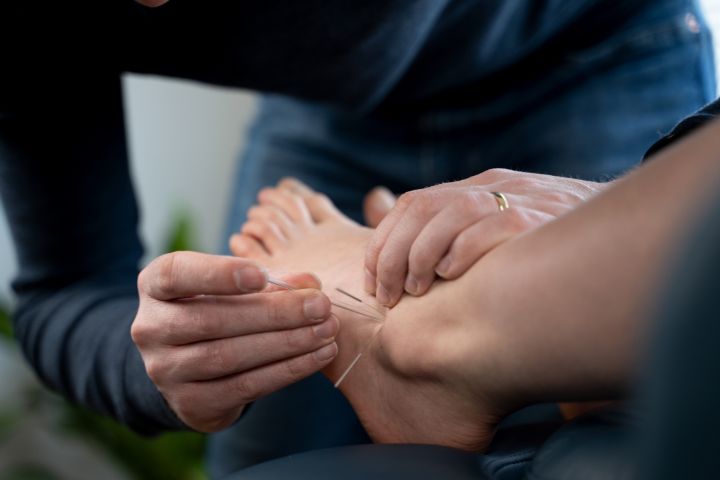While most of our patients understand on some level that dry needling and acupuncture are not the same, it’s common to wonder exactly what the difference is, especially if you’ve had experience with one or the other.
Acupuncture and dry needling both use needles but differ significantly in their origins and applications. Acupuncture, rooted in Traditional Chinese Medicine, focuses on balancing the body’s energy (Qi) by targeting specific points along meridians. Dry needling, based on Western medicine, aims to relieve muscle pain and tension by inserting needles into myofascial trigger points.
In this article, we’ll discuss where each methodology came from, and discuss the differences, and explore the various reasons you would choose one over the other.
Differences between dry needling and acupuncture
Full disclosure, we’re practitioners of dry needling in our physical therapy clinics, and we’re big fans of it! If you’d like to learn more about dry needling specifically, see our full article on what dry needling is, and what it’s useful for.
Though these two practices look similar, we’ll call out some of the differences below:
Historical background and philosophical foundations
Acupuncture has a long history, originating from Traditional Chinese Medicine (TCM) over 2,500 years ago. It is founded on the concept of Qi, a vital energy believed to flow through the body along pathways called meridians. In acupuncture, the balance of Qi is considered essential for health, and acupuncture aims to restore this balance by inserting needles at specific points on the body.
Dry needling, in contrast, is a more contemporary practice rooted in Western medicine. Developed in the latter half of the 20th century, it focuses on the treatment of musculoskeletal pain and dysfunction. Dry needling targets myofascial trigger points—tight, painful knots in muscles—seeking to alleviate pain and improve mobility.
Differing treatment objectives
This is perhaps the main difference between dry needling and acupuncture: their intended purpose. While both acupuncture and dry needling aim to relieve pain and promote healing, their specific applications and therapeutic goals can differ significantly.
Acupuncture can be used to address pain and dysfunction, but it is also often used to solve digestive disorders, mental health conditions, and issues unrelated to tissue damage or injury.
On the other hand, dry needling is a therapeutic modality specifically aimed at musculoskeletal pain and dysfunction. As we called out in our article on the pros and cons of dry needling, one of the advantages of this modality is that it can be used to target certain muscles or portions of a muscle belly directly.
In our offices, we commonly use it to treat conditions such as back pain, neck pain, sports injuries, and muscle strains.
Needle insertion methodology
In acupuncture, practitioners insert needles into specific points along the body’s meridians. The selection of these points is based on the patient’s symptoms and underlying Traditional Chinese Medicine diagnosis.
Dry needling practitioners focus on locating and needling myofascial trigger points. These are areas of muscle tightness that can cause pain and discomfort.
Additionally, the needles used and insertion techniques are different. In acupuncture, the needles are typically finer and are inserted to various depths, depending on the treatment site and condition.
By contrast, physical therapists and other medical professionals who practice dry needling insert sterile filiform needles directly into the trigger points, often eliciting a local twitch response (a brief contract of the muscle being treated).
Some patients report pain from dry needling, but generally it’s very tolerable.
Stimulation techniques
Aside from their differing treatment objectives, perhaps the next most obvious difference is the use of mild electrical stimulation through the needles in the practice of dry needling.
Similar to the electrical stimulation (TENS) units that physical therapists use on the surface of tissue through electrode pads, dry needling practitioners can pass electrical impulses through the needles to elicit a light contraction in the muscle, eliciting blood flow and pain relief.
Unique treatment combinations
Another difference between acupuncture and dry needling is the types of treatment methodologies they may be paired with.
Acupuncture may be combined with other Traditional Chinese Medicine practices such as moxibustion (burning a medicinal herb near the skin), cupping, and herbal medicine.
Dry needling, on the other hand, is often combined with typical physical rehabilitation modalities like therapeutic exercise, manual therapy, heat/cold therapy, etc.

The patient experience with acupuncture and dry needling
The patient experience during acupuncture and dry needling sessions can vary based on the techniques and areas treated.
Acupuncture
- Sensations: Patients might feel a slight tingling, warmth, or a dull ache at the needle sites. These sensations are generally mild and can contribute to a feeling of relaxation.
- Session Duration: Acupuncture sessions typically last from 20 to 60 minutes, with patients often lying still and relaxed during the treatment.
Dry Needling
- Sensations: The insertion of needles into trigger points can cause a brief pain sensation followed by a twitch response in the muscle. While this can be uncomfortable, it is momentary.
- Session Duration: Dry needling sessions are usually shorter, ranging from a few minutes to half an hour, concentrating on specific muscle groups.
Making the Choice
Choosing between acupuncture and dry needling depends on individual health needs, treatment goals, and personal preferences. For those interested in a holistic approach to health and well-being, regular acupuncture might be the preferred option. Individuals experiencing localized muscle pain and seeking targeted relief may benefit more from dry needling on a typical physical therapy schedule of 2-3 times per week for 4-6 weeks at a time.
Consulting with healthcare professionals who specialize in these treatments can provide valuable guidance tailored to one’s specific circumstances. Both acupuncture and dry needling offer unique pathways to healing and pain relief, each with its own set of benefits.

















